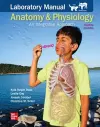
Lab Manual to accompany McKinley's Anatomy & Physiology Main Version
4 authors - Paperback
£167.83
Kyla Turpin Rossreceived her undergraduate degree from Louisiana State University in biological and agricultural engineering and her Ph.D. in biomedical engineering from Georgia Institute of Technology and Emory University. Kyla then served as a postdoctoral fellow in the Fellowships in Research and Science Teaching (FIRST) program at Emory University, a National Institutes of Health (NIH)-funded program that provides training in both research and teaching. In 2008, she joined the Department of Biology at Georgia State University, where she mentored faculty and students, and worked closely with administrators to improve instructional effectiveness in anatomy and physiology courses. She directed teaching assistant training, ensuring quality training in ethics, instructional effectiveness, and risk management. She also taught in a wide range of courses and classroom environments at both the undergraduate and graduate levels. In 2016, Kyla joined the Wallace H. Coulter Department of Biomedical Engineering (BME) at Georgia Institute of Technology and Emory University as the Director of Graduate Training. In 2019, Kyla transitioned to the role of Assistant Vice Provost for Advocacy and Conflict Resolution at Georgia Institute of Technology, where she works closely with administrators, faculty, staff, and students to resolve conflicts in accordance with Institute policies and procedures. Kyla has more than 13 years of experience in physiology education and program development. In addition to teaching undergraduate physiology courses, she provides training opportunities for faculty and students that promote positive lab, work, and class environments. She has been an active member of the Human Anatomy and Physiology Society (HAPS) since 2012, hosted an annual conference, served as HAPS steering committee chair, and will assume the role of HAPS president in July 2021. In addition to academic endeavors, Kyla enjoys traveling and spending quality time with her family and friends. She views life experiences through an optimists lens, and always looks for opportunities to reflect and grow. Christine Eckelreceived her B.A. in Integrative Biology and M.A. in Human Biodynamics from the University of California, Berkeley, and her Ph.D. in Neurobiology and Anatomy at the University of Utah School of Medicine. She has taught a two-semester anatomy and physiology course for pre-nursing and pre health-science majors, and an advanced dissection course for premedical students at Carroll College; stand-alone general biology, human anatomy, and human physiology courses at the University of California at Berkeley and Salt Lake Community College (SLCC); human gross anatomy and medical histology for medical students, and anatomy review courses for residents in orthopedic surgery and pathology both at the University of Utah School of Medicine (U of USOM) and the West Virginia School of Osteopathic Medicine (WVSOM). She has also advised pre-med, pre-PA, pre nursing, and pre-PT students. Christine also headed the Body Donor Program at WVSOM. Christine is the author of Human Anatomy Laboratory Manual, 3e (McGraw-Hill Education). She has also authored several supplements and individual chapters for textbooks in human anatomy and human physiology. Christine is currently serving on the Board of Directors as Secretary for the Human Anatomy and Physiology Society(HAPS). Her previous service to HAPS includes two terms serving as Western Regional Director, and many years serving as Chair and member of the Cadaver Use Committee. Christine has also served on other committees for both HAPS and the American Association of Anatomists (AAA). She is an ad hoc reviewer for the journals Anatomical Sciences Education and Medical Education. Her research is in the field of teaching innovation and educational outcomes research. With over 25 years of experience engaging with community college students, medical students and medical residents in orthopedic surgery, pathology, and gynecologic surgery, Christine has a unique appreciation for the learning challenges experienced by students at all levels. Christines passions for human anatomy, classroom and laboratory teaching, biological dissection, and photography are evident throughout the pages of this laboratory manual. In her spare time, Christine loves to take her English Setter, Zelda, hiking, mountain biking, cross-country skiing, and exploring the great outdoorsalways with her camera in hand.